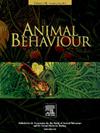任务复杂性很重要:调查大鼠的行为侧化
IF 2.3
2区 生物学
Q2 BEHAVIORAL SCIENCES
引用次数: 0
摘要
行为侧化,如手和爪子偏好,是人类和非人类动物中普遍存在的现象。任务复杂性被认为对行为侧化有影响,即侧化的强度随着任务复杂性的增加而增加。然而,在非灵长类动物物种中,对不同侧化任务的系统比较是罕见的。因此,本研究旨在探讨任务复杂性对家鼠爪子偏好的影响。研究人员对雄性和雌性大鼠进行了五种不同的爪子偏好测试,包括复杂的任务,如获取食物、使用工具或拉绳子,以及简单的日常行为,如攀爬和站立。在所有测试中,评估了爪子偏好的分布,并测试了测试中强度和偏侧方向的差异。研究还考察了爪子偏好的时间一致性,并检验了首先使用的爪子是否表明个体的整体偏好。结果表明,大量大鼠在两项复杂任务(食物获取和工具使用)中表现出强烈的偏侧性,而绝大多数大鼠在拉绳、攀爬和站立时表现为双侧性。此外,只有食物接触和工具使用在侧向化的方向和强度上是暂时一致的。总的来说,力量随着时间的推移而下降。性别没有影响,但先使用左爪的个体更倾向于侧化。综上所述,任务复杂性可以影响大鼠的行为侧化;但是,也应该考虑其他属性,例如任务的新颖性。此外,有利于单爪使用的人工测试情境可能揭示了对爪子的偏好,而常规行为或交替使用爪子则与双侧性有关。这些发现补充了现有的研究,这些研究侧重于食物接触测试,并强调了在不同背景和测试情况下调查行为侧化的必要性。本文章由计算机程序翻译,如有差异,请以英文原文为准。
Task complexity matters: investigating behavioural lateralization in rats
Behavioural lateralization, such as hand and paw preferences, is a widespread phenomenon among humans and nonhuman animals. Task complexity is assumed to have an influence on behavioural lateralization, that is the strength of lateralization increases with increasing task complexity. However, systematic comparisons of different lateralized tasks in nonprimate species are rare. Therefore, this study aimed to investigate the influence of task complexity on paw preference in a rodent species, the laboratory rat, Rattus norvegicus f. domestica. Male and female rats were tested in five different paw preference tests, including complex tasks, such as food reaching, tool use or string pulling, and simple routine behaviours, such as climbing and standing. For all tests, the distribution of paw preferences was assessed, and the differences in strength and direction of lateralization were tested among the tests. The temporal consistency of paw preference was also investigated, and it was examined whether the paw used first indicates an individual's overall preference. Results showed that a large number of rats were strongly lateralized for two complex tasks (food reaching and tool use), whereas the vast majority was ambilateral for string pulling, climbing and standing. Furthermore, only food reaching and tool use were temporally consistent in the direction and strength of lateralization. Overall, strength decreased over time. Sex showed no effect, but individuals that used the left paw first were more strongly lateralized. In conclusion, task complexity can affect behavioural lateralization in rats; however, other attributes, such as task novelty, should also be considered. Moreover, artificial test situations, which favour the use of a single paw, likely reveal paw preferences, whereas routine behaviours or alternating paw use are associated with ambilaterality. These findings complement existing studies that focused on food reaching tests and underline the need for investigating behavioural lateralization in different contexts and test situations.
求助全文
通过发布文献求助,成功后即可免费获取论文全文。
去求助
来源期刊

Animal Behaviour
生物-动物学
CiteScore
4.60
自引率
8.00%
发文量
236
审稿时长
10.2 weeks
期刊介绍:
Growing interest in behavioural biology and the international reputation of Animal Behaviour prompted an expansion to monthly publication in 1989. Animal Behaviour continues to be the journal of choice for biologists, ethologists, psychologists, physiologists, and veterinarians with an interest in the subject.
 求助内容:
求助内容: 应助结果提醒方式:
应助结果提醒方式:


